At Attitudes Dance and Fitness in Billerica, Massachusetts, Associate Professor of Entrepreneurship Brad George, who is the co-owner and chief financial officer, considers himself “a behind-the-scenes jack of all trades.” While co-owner and artistic director Dawn George oversees ballet, jazz, contemporary dance, hip hop, and tap classes for children along with dance and fitness classes for adults, Professor George handles business and marketing strategy along with accounting responsibilities. By bringing his experiences back to the classroom, he hopes to impart knowledge about all aspects of owning a business.
“Students think about the big, glamorous businesses; most startups are not big or glamorous,” Brad George says. “Even with a relatively small business, you deal with a lot of the same issues, things you don’t necessarily read about.” For example, he says the pressure of finding new space after their building was sold almost led the Georges to close their business.
In owning the dance studio, Brad and Dawn George have put their business first and have dealt with making sacrifices, which is a key lesson he has conveyed to his students.
“Most businesses require you to put most of your time and money and everything else into them,” Brad George says. “You don’t want to get in there and realize: ‘This is not at all what I thought it was going to be.’”
He also asks his students to determine what they hope to get out of their ventures. For Brad and Dawn George, their focus is on serving the community. “We have a very different set of goals for our business than other people might,” Brad George says. “I’m a big believer that entrepreneurship isn’t about making the most money; it’s about having a life you want to live.”
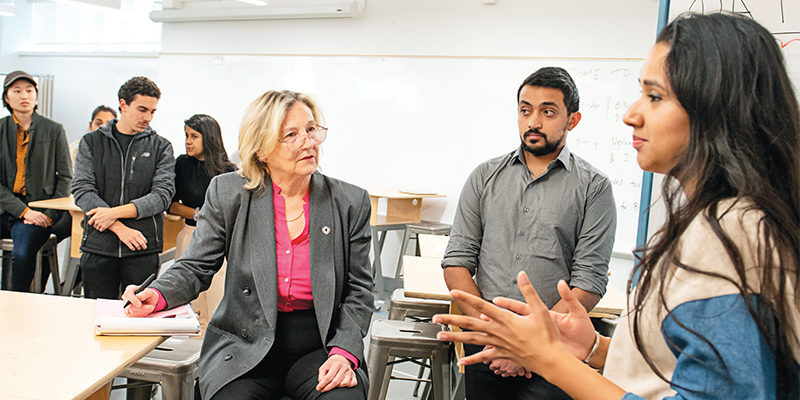
Senior Lecturer Caroline Daniels teaching in the Design Zone at Babson College.
Photo: Webb Chappell
Lessons from Overcoming Challenges
For more than 20 years, entrepreneurship senior lecturer Caroline Daniels managed Daniels Island Properties in Nantucket, a company that built and purchased properties on the island and rented them out to vacationers during the summer months.
On most summer days, Daniels would be in constant contact with architects, building contractors, and real estate professionals responsible for marketing her properties. At the end of each summer, Daniels would close up shop for the winter.
“In any business, you run experiments,” says Daniels, who also has started other ventures, most notably in strategy consulting. “You have to find a really good niche to operate in, and you need to have great customer supplier and other stakeholder relationships.”
When she returned to Babson each fall, Daniels would share stories of how she overcame adversity in her business. Her most frequent tale, she says, involved an early morning delivery of incorrect parts for a home soon to be constructed. She has told her students how she solved the problem by involving everyone as a team to find a solution.
The experience of overcoming a challenge can serve as an inspiration and a how-to for students, Daniels says. “The joy for me in combining both practical, entrepreneurial experience and academic teaching is that I get to share everything I’ve learned with students and give them a pathway. I feel that reduces the risk for them.”

Sandra Bravo MBA’87 working on her consulting business, Bravo Communications.
Photo: Webb Chappell
Getting the Students Involved
For the past 25 years, marketing lecturer Sandra Bravo MBA’87 has helped small businesses grow through her consulting business, Bravo Communications.
“I understand the entrepreneurial mindset,” she says. “It’s fun to have a front-row seat to see what these people accomplish.”
At the same time, Bravo has done volunteer work and occasionally has merged her professional and pro-bono lives. Most recently, she has worked with Friends of Children Inc., a Western Massachusetts organization that helps foster children receive supplies and money for things they need, in addition to easing the transition out of foster care once they turn 18.
Bravo has involved her past students by having them help Friends of Children build its social media presence. Students also have been tasked with creating content calendars and generating marketing ideas.
“It’s hard to explain how important this work is, and how much my Babson students stepped up to the plate,” she says. “We have students who are smart and compassionate, and they know they have the ability to have a voice. It’s so energizing and gives me so much hope for the future. Once the students get invested in something, they know they have the resources to fix it. That equation can add up to amazing things that can be done for the world.”
]]>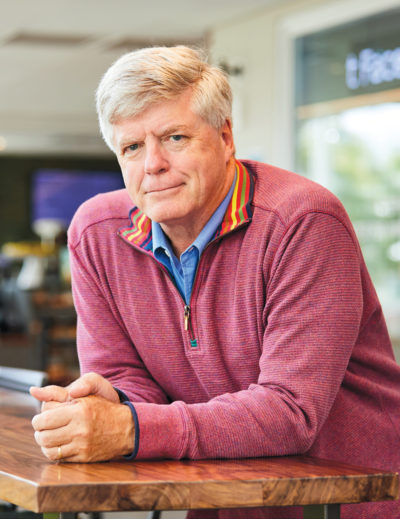
“There is not cause for mass panic. The fact is that nobody really knows the percentage of jobs that will be automated over what time frame.” – Tom Davenport, the President’s Distinguished Professor of Information Technology and Management
Photo: Pat Piasecki
Let’s clear up one thing first: Contrary to what you may have seen in the movies, killer robots won’t be running amok anytime soon.
“There is not much evidence that killer robots are coming for us in the foreseeable future,” says Tom Davenport, the President’s Distinguished Professor of Information Technology and Management.
That’s not to say that the never-ending march of technology, particularly in regard to artificial intelligence (AI) and machine learning, doesn’t pose legitimate concerns about bias, misinformation, and a host of other possible issues. As AI grows more sophisticated, it will become a greater part of our workplaces and our lives.
For now, at least, the changes brought by AI are incremental, says Davenport, who has written two books on the technology, including The AI Advantage: How to Put the Artificial Intelligence Revolution to Work. Davenport tends to believe in Amara’s Law, which says humanity typically overestimates the effect of a new technology in the short run and underestimates the effect in the long run. “So far, the changes with AI are evolutionary rather than revolutionary,” he says. “It’s not something to be scared of.” Instead of fear, what AI represents is opportunity. For workers, AI potentially offers a way to do their jobs better. Furthermore, for entrepreneurs and business leaders, the new technology means new ventures, new ways of thinking, and new possibilities. Davenport encourages all businesses to look into AI. “You don’t want to be left behind,” he says.
AI at Work
Perhaps the biggest concern about AI is the potential loss of jobs from the technology. Just how many jobs could be lost, though, remains unknown. Headline-grabbing reports predicting massive unemployment appear to be overblown, Davenport says. “There is not cause for mass panic. The fact is that nobody really knows the percentage of jobs that will be automated over what time frame.”
Of course, some jobs are at more risk than others. Jobs that require empathy, creativity, or flexibility are harder to replicate than those with repetitive, predictable tasks. Jobs that require direct human contact (nursing, for example) also are safer than those that are predominantly performed digitally (radiology). “You want to make sure you are doing things that aren’t easily replaced by a machine,” Davenport says. “My son is a TV comedy writer. Machines are very bad at comedy writing.”
In many workplaces, however, employees may find their jobs augmented, rather than automated, by AI. Instead of replacing humans, says Davenport, machines could complement them and serve as a colleague of sorts, performing tedious tasks or helping workers make complex decisions.
One company bringing AI to the workplace is Gravyty, a provider of AI-enabled fundraising software. Based in Newton, Massachusetts, Gravyty works with colleges, hospitals, and other nonprofit organizations that are tackling a range of serious societal challenges, such as treating Alzheimer’s disease, curing cancer, and eradicating poverty.
“Our mission is helping their mission,” says Gravyty’s chief technology officer, Rich Palmer MBA’16, who co-founded the company with CEO Adam Martel, a Babson MBA candidate who once worked in the College’s development office. “We take inspiration from all of our clients. They are doing all kinds of beautiful things for the world.”
Gravyty offers clients a variety of AI-powered capabilities. Its software, for instance, can identify and prioritize potential donors in each client’s network.
One organization was able to land a $50 million gift after Gravyty software singled out a new potential donor. “He was in a pool of people they knew about, but no one had previously taken the time to talk to him,” Palmer says.
Gravyty’s software can draft emails to send to donors, and when fundraisers make edits to those emails, the AI is taking note. “The AI system is constantly learning how you talk,” Palmer says. “The more you use the system, the better it gets. The next time an email comes up, it’s a little better.”
Gravyty also can help clients organize their fundraising trips, figure out which potential donors to meet for coffee or take to dinner, and even suggest restaurants where they should dine. That scheduling can save fundraising staff a lot of time.
“Fundraisers already do a lot of this, but it may take them all day to set up a meeting,” Palmer says. In fact, Gravyty case studies have shown that its products enable one fundraiser to do the work of 10. Have a staff of 10, the company claims, and they can now do the work of 100.
That’s welcome news for an industry that is always in need of talent. “There is a lot of turnover,” Palmer says. “Every nonprofit has open jobs now.”
AI in Our Lives
Outside the workplace, AI may influence our lives in myriad other ways in the future, says Davenport. To name just a few possibilities, AI may help analyze the human genome, assist doctors in predicting who might have a heart attack, or increase the mobility of seniors through autonomous vehicles.
Waycare, based in Los Angeles and Tel Aviv, Israel, is using AI to create safer, less-clogged roadways. Typically, says co-founder and CEO Noam Maital ’12, accidents and congestion are responded to after the fact. Two cars collide, and that’s when police are called to the scene. Traffic backs up, and that’s when motorists are notified of the delay by phones and news reports. “A big problem is that we are reactive by nature,” Maital says.
Waycare seeks to change that. Utilized by municipalities and departments of transportation, Waycare’s AI platform analyzes all kinds of data—from accident reports to traffic cameras to weather forecasts to navigation apps on driver smartphones—to predict congestion and accidents before they happen. “The data is overwhelming, but it can be turned into actionable insights in real time,” Maital says.
That’s what happened in Las Vegas. Waycare was used to cut vehicle crashes by 17 percent on a stretch of city interstate last year. The company identified when and where crashes were likely to happen, and then government agencies took steps to reduce motorists’ speed. Digital highway signs prompted motorists to slow down, and police cars with flashing lights were stationed in high-risk areas.
For cities dealing with traffic problems, Maital thinks technology offers a better and more cost-effective solution than trying to expand roadways and overhaul infrastructure. “They can’t pave themselves out of the problem fast enough,” he says. “They have to be smarter.”
Waycare and Gravyty illustrate the capability that AI has to improve our day-to-day lives, both in the office and out. They also show AI’s business potential, which is far-reaching. “In my mind, no industry is immune to the transformational potential of AI,” says Gravyty’s Palmer.
Indeed, the technology is moving ever forward. That relentless progress is not something to fear, but it’s also not something to ignore. “There are serious first-mover advantages to adopting AI,” Palmer says. “Now is the time for entrepreneurs of all kinds to put AI to work or they’ll fall behind, and it may be hard to catch up.”
]]>She is a mother of two, for starters, and she works at pharmaceutical company Sanofi as a director of analytical science and technology.
She also is board president at the Wellesley Chinese Language School, an institution she helped launch a decade ago because she saw a glaring need for the language and cultural instruction it could provide. She and her co-founders worked night after night into the wee hours to make the school a reality.
Despite all these responsibilities, however, Kochling is driven by a need to push herself even further. She is not content to be still. “I love challenges,” she says. “I am constantly looking for new ideas.”
For that reason, Kochling enrolled at Babson. She always had wanted to earn an MBA, and with her children growing older—one now in college and the other in high school—she thought the time was right. She hopes the degree will be a springboard for more career opportunities.
Earning an MBA also allows her to experience the joyful and fulfilling act of learning, something she values greatly. “Learning is part of me,” Kochling says. “I love to learn new things.”
Babson is a place that believes learning doesn’t end at age 21 with a walk across the stage and a mortarboard toss into the air. For sure, balancing education with adulthood’s many commitments isn’t always easy, but continuing to pursue learning opportunities can be rewarding and, frankly, essential to a vibrant career. With extensive courses and programs available at Babson Executive Education (BEE) and the F.W. Olin Graduate School of Business, including a fully online MBA degree launching in January, the College believes it can be a lifelong home for those seeking knowledge.
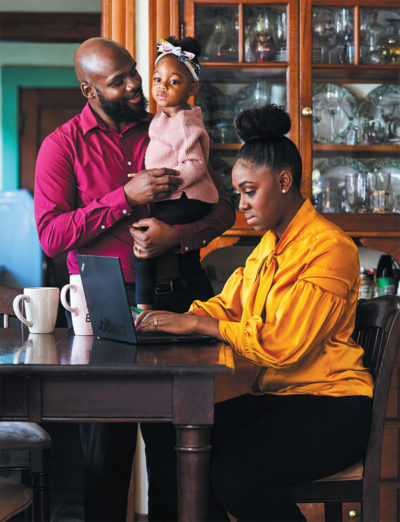
Chavon Cham MBA’18 at home with her husband, Gilbert, and daughter, Noah.
Photo: Pat Piasecki
“We can be here when you’re an undergrad, and a grad, and an early-stage professional, and as you advance throughout your entire career,” says Karen Hebert-Maccaro, BEE’s CEO. “We want to partner with you for every stage of your life.”
Constantly Evolving
Learning can’t stop because the world doesn’t stop. Technology is moving forward. Skills grow outdated. “Work is constantly evolving as it becomes more global and digital, and most jobs are slowly being replaced or reimagined through technology,” says Keith Rollag, the Murata Dean of the graduate school. “Staying productive, successful, and employable over time means we need to constantly learn new things.”
Hebert-Maccaro recommends that employees look at learning almost like going to the gym. “For physical survival, you need to pay attention to what you eat and how you exercise,” she says. “For intellectual survival, you need to exercise those mental muscles as well.” And, just like going to the gym, finding the time to learn can be a challenge. “We all have to juggle a lot in our lives,” Hebert-Maccaro says. “The most successful people will figure out how to juggle family, life, and continuous professional reinvention.”
Dr. Jason Simon MBA’20 knows all about that juggling. He’s an orthopedic surgeon at Newton-Wellesley Hospital, and sometimes when he’s supposed to be in class, he’s in the operating room.
He’s also the father of two daughters in grade school, and they occasionally pop up on the screen when he’s on a WebEx conference with his Babson classmates. Additionally, Simon is a senior executive at 1854 Cycling Company, a bicycle and apparel brand that provides jobs to formerly incarcerated people. “It’s a big social mission project, and that’s why I make time for it,” he says.

Dr. Jason Simon MBA’20 at Newton-Wellesley Hospital.
Photo: Michael Quiet
Of course, Simon is used to going to school and being busy. He is a doctor, after all. He experienced the whirlwind that is medical school. “In medicine, school never ends anyway,” he says. “I am fairly certain I haven’t slept since 1997.”
Simon decided to earn his MBA because the business of medicine is shifting. “It’s not really run by physicians but by practice managers who have a business, not a clinical, background,” he says. Finding himself surrounded by people “throwing out business terms,” essentially speaking a language he didn’t understand, Simon decided to apply to Babson. “The reason I’m in medicine is to take care of people,” he says, “but if that’s hampered by the way medicine is changing, you have to change.”
Like Simon, Chavon Cham MBA’18 decided to pursue an MBA to aid her career. When she studied at Babson, she was a New Balance product manager but preparing for a shift. Instead of focusing on product creation, she was aiming for a position that was more strategic, more global, more big picture. “I wanted to manage the business from a strategic point of view,” says Cham, who today is a global product manager for women’s lifestyle footwear at New Balance.
Also like Simon, Cham had to do some juggling to make her education work. During her time at Babson, she not only gave birth to her daughter, but she also planned a wedding. “It was very busy,” she says. Cham’s professors and fellow students were supportive, however, and she learned to manage expectations with class projects. “I couldn’t be the first person on every discussion board every week. There were times I had to flex,” she says. “It was about setting boundaries.”
Cham was enrolled in the Blended Learning MBA program, and she found its mix of online and in-person sessions provided flexibility that worked well for her bustling life. “You picture an MBA to be way more stuffy and conservative,” she says. “That wasn’t the experience for me at all. It was feasible and doable.”
Always a Babson Student
The Blended Learning program may be flexible, but some potential students live too far away to be able to come to campus regularly. Babson is striving to change that. “We want to expand our impact by reaching more students,” says D.R. Widder MBA’99, Babson’s vice president of innovation. “We want to foster entrepreneurship and Babson everywhere, and being online is a prerequisite to being everywhere.”
In January, Babson will begin offering an MBA program fully online. Other online programs will follow. “The main goal of online is to reach those students who can’t reach us,” says Widder. “We want to give people a way to get the world’s best entrepreneurship education wherever they are.”
Increasing access to what Babson offers is a goal at BEE as well. It already provides a robust selection of open enrollment and custom programs for individuals and companies, but Hebert-Maccaro wants to do more. Whether an employee needs to solve a problem in the moment, requires a new skill, or clamors for a complete career transformation, she wants BEE to be the place where they can gain that expertise. To do that, BEE could provide a variety of offerings—a class, of course, but also a podcast, a video, or whatever else is required. “I am bullish when I’m thinking about the potential Babson has,” says Hebert-Maccaro.
The mission is to further empower a life to be spent in learning, a life only beginning when one crosses the stage with a diploma in hand. “We all should be continually learning,” Widder says. “Once a Babson student, you are always a Babson student.”
]]>These guides typically are Babson graduates who have achieved success in their fields and are eager to give back. In turn, the relationships they develop with students add a rich layer to their own professional development.
Take Hugh Glazer ’77, P’13. He spent the early part of his career as a certified public accountant, working at the New England Journal of Medicine and Simon & Schuster. Today, he runs the WinterView Group, which provides CFO services to private companies and nonprofits.
He also is a business advisor in the 10,000 Small Businesses Program, a joint venture between Babson and Goldman Sachs. The program, which provides access to education, capital, and business support services, is “a 13-week business bootcamp for CEOs,” he says, many of whom are trying to grow their families’ small businesses.
He reflects on a young woman who was overwhelmed by taking over a family business from her parents because she’d never had an active role in it. When Glazer suggested a change, she said, “Are you really going to give me permission to do that?” It was a watershed moment for the nervous entrepreneur.
“I said, ‘It’s got nothing to do with me! You have to give yourself permission.’ This is how a mentor can help someone—be a sounding board.”

Dana Harris MBA’91 is on campus regularly for mentoring and guest lectures.
Photo: Webb Chappell
Glazer serves as a coach through Babson’s Coaching for Leadership and Teamwork Program (CLTP), which provides undergraduates with one-on-one developmental coaching on their leadership, communication, and interpersonal skills early in their careers. He has been involved with the program since its inception, brought along by Professor Joe Weintraub, CLTP founder and faculty director, a longtime friend and mentor. In his session of the program, roughly seven students participate in a two-hour case study that they’ve never seen before, receiving real-time feedback from seasoned coaches such as Glazer. Students participate in their first year and again as juniors or seniors, sharpening their analytical skills.
“This is one of the programs that have drawn accolades for Babson,” he says. In addition, his work with students and other coaches has changed his outlook.
“Oftentimes, you might make a snap judgment. ‘Gee, wow, this person is going to be tough to work with.’ And, once you get going, you find out they have all kinds of insights. So, for me, the CLTP program over the years has really taught me an awful lot about managing people, interacting with people, and how to just judge people on what they say and do, so to speak, versus what your visual cue might sometimes say to you,” he says.
Professional Gratification
Dana Harris MBA’91 is a partner at Red Javelin Communications, a boutique PR and marketing agency, focusing on technology and industrial companies. She is a longtime B.E.T.A. (Babson Entrepreneurial Thought & Action®) competition judge through The Arthur M. Blank Center for Entrepreneurship, as well as a regular mentor and a marketing guest lecturer. In April, she was an advisor in the Mega Mentoring session at the Founders Summit centennial series of workshops. There, 100 alumni matched with 100 student entrepreneurs for discussions. Harris consulted on brand messaging and marketing.
“You almost feel like (the participants have) full-fledged companies, but they’re students. They’re doing double time over at Babson,” she says, laughing. “It’s unbelievable and so impressive—not something I could’ve been doing back in my day.”
She recalls meeting with Ryan Lupberger ’18, a founder of CleanCult, a subscription service that aims to deliver effective, nontoxic laundry pods. Seeing her direct mentorship provide real results for Lupberger’s team was a rewarding experience, Harris notes.
“They wanted to pursue similar branding to a competitor and wanted tips on how to do that. I was able to provide advice on how to use content to create relationships with customers—how to use video, SlideShare, social media, and blog posts—and give them advice on their brand voice. This company went on to win the B.E.T.A. Challenge and the MassChallenge, which are two very prestigious startup competitions in the Massachusetts area,” she says.
“Seeing someone else take my advice and then applying it was so gratifying—and it validates my own education. I felt that it made my experience valuable in a way it never did before. I’d say that is the one thing that I really love about mentoring: It gives me a newfound sense of responsibility and achievement in reaching a career milestone where I’m able to help people and give back.”
Learning From Students
Chris Jacobs ’10, meanwhile, brings his entrepreneurial talents directly to the classroom. As the founder and CEO of Honest Discounts, a company that provides savings on prescription drugs, he has regularly taught Professor Len Green’s Ultimate Entrepreneurial Challenge class. (Bloomberg Businessweek named Jacobs one of America’s best young entrepreneurs in 2009.)
Jacobs calls Green the “Obi-Wan Kenobi” of Babson. “He’s the ultimate mentor,” Jacobs says, noting that he was honored to be a guest lecturer.
“It’s a long-running class, and it fills up right away. It’s an amazing experience. … Everybody wants to take it. All the (students) who want to build companies want to take it,” he says.
Jacobs presents case studies from his company without disclosing its name, allowing students to present their ideas. Then, he tells them what actually happened and grades each presentation. Mentoring these blossoming entrepreneurs has helped him think about his business in different ways, he notes.
“When you teach someone something, it really forces you to think about what you’re saying and how to articulate it,” he says. “When I start talking about a sales operation strategy or I come up with an idea for a student, a lot of times I think, ‘I should be doing that myself!’ Just through talking about the student’s problem and how I would solve it makes me a better problem-solver.”
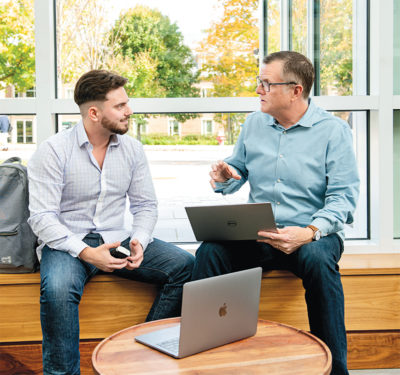
Dillon Galynsky ’20 talks to his mentor and friend, John Grayson MBA’97, P’20.
Photo: Webb Chappell
An Enduring Relationship
Sometimes mentorship results in a long-term friendship. John Grayson MBA’97, P’20, executive vice president of Agbotic Inc., met student Dillon Galynsky ’20 through the Babson Summer Venture Program as Galynsky launched HUSH, a smoke filtration device that eliminates fumes and odor, captures ash, and reduces secondhand carcinogens.
“Business success is often measured in dollars and cents, but a successful mentor-mentee relationship produces a meaningful and long-lasting impact at a personal level,” Grayson says. “That’s hugely rewarding for both the mentor and mentee.”
“We just hit it off,” recalls Galynsky. Grayson took an interest in him as a person, not merely as an entrepreneur, he adds.
“We ended up meeting outside of Babson and spending more time together. It first started from a mentorship capacity, and then it grew to a friendship, which is very important because there’s a level of trust that evolves over time. I’d call John and ask him questions about my life that didn’t even have to do with the business,” he says.
For mentors, the end goal—seeing students succeed—is as fulfilling as their own careers.
“Babson has been able to turn out fabulous students who are just so entrenched in taking their education, what they’re learning in the classroom, and bringing it into the real world and applying it in companies in ways I’ve never seen before,” says Harris. “It’s amazing.”
]]>Since then, Kerry Healey was named the first female president in 2013, and Marla Capozzi MBA’96 first female chair of the Board of Trustees in 2017. The Centennial undergraduate class of 2019 was the first to have a female majority. In September, women from the first decade of graduating classes will return to the College as the Pioneering Women of Babson, partnering with the Center for Women’s Entrepreneurial Leadership to support current and future students and alumnae and inspire engagement and donations.
We asked some of these women to share their memories of campus and to offer advice to women students today.

Carolyn Levosky MBA’69
Photo: Webb Chappell
Carolyn Levosky MBA’69
The first woman to earn a master’s degree
“These were changing times, but I still thought it was very brave of Babson to accept women. It was a bit experimental on their end, but I’m sure they saw the trends. The MBA students were a little older, and very welcoming, very open-minded.
“I was not trying to prove anything. When I graduated, they put my picture on the front page of The Boston Globe. It was a very big event. But I was just trying to do a good job for the next group of women, and I was glad to be early in the game. I think the writing was on the wall that women were going to go to graduate school and into the workforce in a big way.”
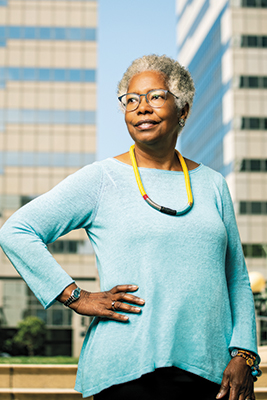
Sharon Rowser ’74
Photo: Winni Wintermeyer
Sharon Rowser ’74
“I was offered a full scholarship, and Babson showed a lot more interest in me than other schools I applied to. The civil rights movement was happening during that time, and colleges were reaching out to bring more minority students in, so I knew I was part of that. There was definitely a sense in those days that you were representing your people. A lot of single-sex schools were becoming coed then. What was more startling was how small the African-American population was. I was the only African-American woman in the school my first year. It’s complicated, and a bit emotional, too; it made me feel pretty alone, even though in high school it wasn’t unusual for me to be in classes with few African-Americans. Freshman year was the hardest, and it was definitely the living and social parts that made it hard. I felt I was as smart as everyone else, and I wasn’t afraid to show that. I was part of the Black Students Union, and we worked as a group to recruit more students of color in my first two years at Babson.”
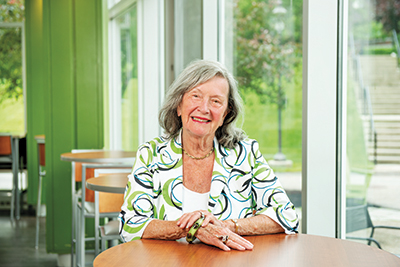
Sandra Adams ’70
Photo: Webb Chappell
Sandra Adams ’70
One of the first two women to earn undergraduate degrees
“I wanted to be an investor, so I transferred from Wellesley College in 1968. Babson had a good program. I was pleased to go there. I was a bit older and already had children. The guys were wonderful. They were as nice as they could be, even if they never saw anything like us before on campus. I had a great time. I wish I could be that age again and do it all over. Babson has a lot of women now. Isn’t that fantastic? I think they would be very happy to step into what Babson offers. It’s all there for them.”
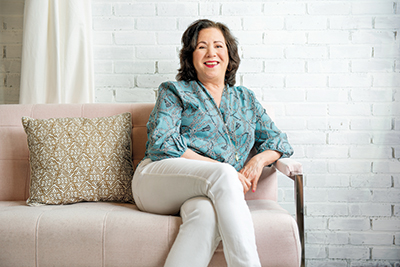
Phyllis Speen ’74
Photo: Webb Chappell
Phyllis Speen ’74
“When I came to Babson I didn’t really think about being one of few women. I wasn’t intimated by that. As women we just did what we wanted to do. A percentage of the guys at Babson came from all-male prep schools, and they weren’t sure how to treat women academically or even socially. They looked at you as a nuisance, usually not as dating material. And then there was a percentage that just were like brothers and would help you. The one thing you’ll hear from many women or men who were the first of something, was that we had the burden of having to succeed no matter what, because we were representative. For three-quarters of my career, I was usually the first or only woman in my role. I never knew not needing to succeed, because I was afraid it would be looked at as women couldn’t do it, versus Phyllis couldn’t do it.”
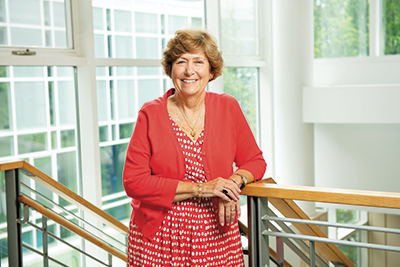
Anne McCormick Heller ’70
Photo: Webb Chappell
Anne McCormick Heller ’70
One of the first two women to earn undergraduate degrees
“There were only two of us in the undergraduate school. And there were no women faculty. There were no women in senior positions. There were no women’s sports. No clubs. I was working hard. It was competitive, but the male students treated me great. They were collegial and easy. I became part of campus life and was on student government. I had great professors. They made me totally comfortable in the classroom.”
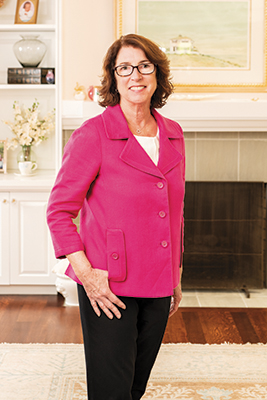
Ellen Monahan Saliba ’74, MBA’80
Photo: Winni Wintermeyer
Ellen Monahan Saliba ’74, MBA’80
“I entered Babson in September 1970. That was the pivotal point. Prior to that, there were a few women. But that September, they admitted about 25. It was not pervasive, but there was an attitude of, what are these women doing here? That kind of stuff went away pretty quickly as they got to know us. We were there to get an education. I don’t think any of the women chose Babson to make a statement.
“We stuck together. To walk into Trim Dining Hall, it was uncomfortable at times. We felt we were very visible, so we would gather at 5:30 in the dorm and walk over together. The women were such a good support structure. We were allowed to put our mark on the school by being leaders on the newspaper, yearbook, student government. I got a great education. I was so well-prepared for life and for working in a world that is male dominated.”
The Pioneers’ Words of Wisdom
Ellen Monahan Saliba:
“Life is long. Keep going. Don’t let a roadblock slow you down from what you want to do.”
Anne McCormick Heller:
“It’s a global world. Take advantage of the international population at the undergrad and grad school. Meet these folks.”
Carolyn Levosky:
“If you’re competent and really know what you’re doing, when you’re speaking to someone, they’re going to listen to you. It doesn’t matter if you’re a man or a woman. If you have credibility, that makes a huge difference.”
Sharon Rowser:
“We’ve made strides, both racially and genderwise, but we still have to pay attention, because discrimination has not gone away.”
Phyllis Speen:
“If you’re in sales, know your audience and talk in terms of their world. Selling is a skill. It’s about listening, asking questions, and understanding someone’s perspective. We should really change the word ‘sales’ to ‘communication’.”
That meant she’d need to learn how to pitch to potential investors, something out of her wheelhouse. Jaffar knew this process wouldn’t be painless. There would be tough questions. And challenges. And more questions. Lots of questions.
“We had to do it,” she says of the practice pitch sessions done during the Summer Venture Program, a business accelerator that’s part of The Arthur M. Blank Center for Entrepreneurship. “We needed to feel uncomfortable, and we needed to be OK with that feeling, because this is going to happen—this is going to be real.”
That experience allowed Jaffar to up her game—and her self-assurance. “I realized,” she says, “that people could look at me and say, ‘She’s good, we want to give her a chance.’”
The business world doesn’t always offer men and women a level playing field when it comes to starting an entrepreneurial venture. Women who want to start companies or take their entrepreneurial mindset to startup or corporate executive roles may face daunting challenges. They are often passed over as leaders, denied representation in C-suites, challenged on their knowledge and skills, find it considerably more difficult than men to secure funding for new businesses, and lack established networks that can help them succeed.
But women like Jaffar are finding that they can gain a decided advantage with a solid business education, undergraduate and graduate, that emphasizes entrepreneurship and experiential learning. That type of education happens in the classroom and via programs offering coaching and mentoring, plus guidance in building essential networks. In Jaffar’s case, her pitch for an eponymous modest and fashionable clothing line earned her a finalist spot in the Blank Center’s B.E.T.A. (Babson Entrepreneurial Thought & Action®) Challenge, which celebrates entrepreneurs who are bringing their business ideas to life. She also was given support from the Babson Seed Fund and received the Sorenson Scholarship Award for Meritorious Achievement. Jaffar was awarded the Female Founder Impact Award from the Center for Women’s Entrepreneurial Leadership (CWEL), one of few business school centers in the country that focuses on women. After graduation, Jaffar moved to New York, where she is working full time on her venture, and “continuing the road that Babson paved for me.”
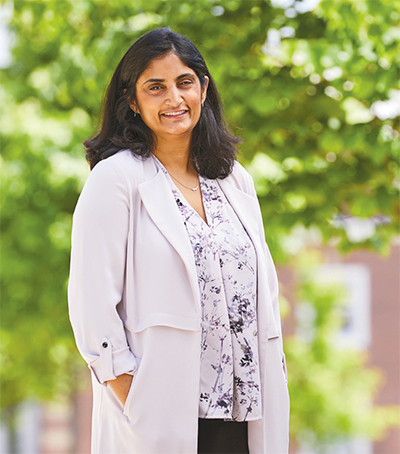
Lakshmi Balachandra, assistant professor of entrepreneurship
Photo: Pat Piasecki
For any industry, “the more knowledge and prep you have, the better,” says Lakshmi Balachandra, an assistant professor of entrepreneurship who teaches Foundations of Management and Entrepreneurship, a required first-year course where students work in teams to build, launch, and run an actual business. Similarly, Babson’s Management Consulting Field Experience (MCFE) pairs Boston-area companies with student teams who work as consultants on actual business challenges.
“When you come to an entrepreneurship class,” Balachandra says, “you learn about the foundations of building a business plan, and how to prepare the financials the way investors want to see them. Having that educational component gives you a huge leg up.”
But the most important component, she adds, may be learning how to work with other people: “How do you lead, how do you communicate with investors, how do you manage all these moving parts?” That students are thrown into these situations from day one makes the program unique, and offers women opportunities they may not get in the real world, especially starting out. Balachandra adds that she has seen more women pursuing and attaining leadership roles in the class, “and that has been incredibly exciting.”
From Mentee to Mentor
“I don’t think you can go into entrepreneurship without thinking it will be hard,” says Mackenzie Page ’20. Choosing entrepreneurship factored into her becoming a CWEL Scholar, which not only provided a partial scholarship, but also tremendous opportunities for working with a mentor, becoming a mentor, and creating a network of like-minded women.
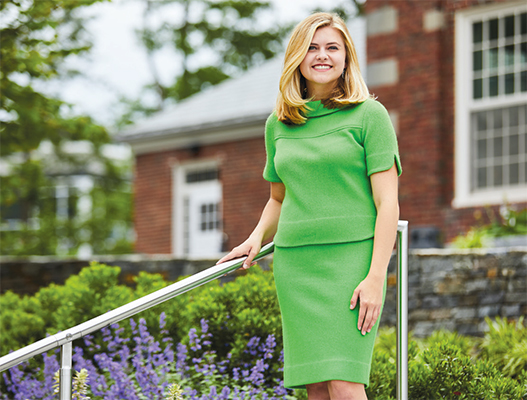
Mackenzie Page ’20, a CWEL Scholar
Photo: Pat Piasecki
Page’s CWEL experiences have been profound. “When I first came to Babson, I had a really great peer mentor,” she says. “She was excellent in showing us how strong we could be, how much we could embrace—she was a great role model, and this was my first glimpse into what a mentorship can be.”
Taking part in CWEL networking sessions has allowed Page to feel comfortable approaching complete strangers in business-social settings, which can be daunting for some. “It has really lifted my confidence,” she says. In her first-year FME class, she was a co-CEO with a male classmate, and learned how creative problem solving could tackle tough challenges. In her second year, she became an FME mentor to first-year students, which she calls “a fantastic experience.”
Changing the System
Make no mistake—educational programs that help women become entrepreneurs are no indication that women’s skills and abilities are inferior to those of men.
“The solution to challenges women face in starting and growing businesses is not just to educate, train, or fix the women” says Candida Brush, vice provost of global entrepreneurial leadership and the F.W. Olin Distinguished Professor of Entrepreneurship. Rather, the system needs to change. A male-dominated finance industry, for example, needs to recognize that women-owned businesses are worthy of investing.
“One of the reasons why Babson’s WIN (Women Innovating Now) Lab® was created,” she adds, “was because women were being left out of highly competitive venture accelerators. The education and mentoring that the WIN Lab provides is the same support available in other accelerators.” The WIN Lab, which is part of CWEL and found at Babson’s Boston and Miami campuses, allows women to expand their ventures by testing and tweaking their ideas. Women also have access to experts in various fields, and opportunities to showcase their company and be coached on how to pitch.
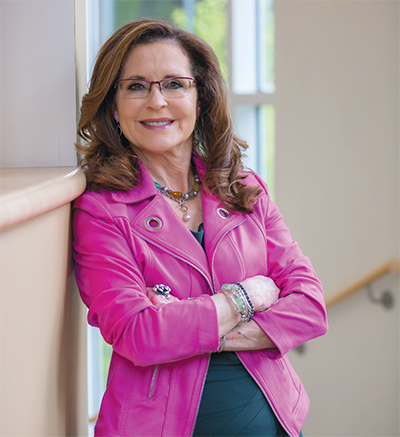
Susan Duffy, executive director of CWEL
Photo: Dan Vaillancourt
Susan Duffy, CWEL’s executive director, says the center adds to the “already exceptional functional education that Babson is providing. This center is about building that successful entrepreneurial leader and giving them the tools they need to identify opportunities and overcome challenges that may arise as they navigate their careers.” Combining mentorship, leadership acumen, networking, and immersive learning experiences, she adds, “CWEL emphasizes business skills, while creating opportunities for emerging women leaders to build their self-efficacy— something that research tells us is vital to success.”
At her summer internship working in data operations and analytics for an insurance group, Page already can see the benefits of what she has learned, including presentation skills she has drawn on for her job. “In FME, you have to do presentations throughout the year, and that helps you build up your confidence,” she says. “Early on at Babson, it was quite apparent to me what the College was preparing me for. Like most people I’m nervous on my first day of a new job, but it’s great to remind yourself that you have tons of classwork and experience under your belt.”
]]>But Spinelli is an entrepreneur, and, as of July 1, he became the new president of Babson, the home of entrepreneurs of all kinds. He looks at all the doubt and upheaval a bit differently from others. He sees not chaos, but possibility. “The level of change in the world is so dramatic,” he says. “From an entrepreneur’s perspective, this is our time.”
A long-time member of the Babson community, who first stepped foot on campus in the 1980s to begin pursuing his MBA degree, Spinelli takes over leadership of the College as it’s celebrating its Centennial and looking ahead to its second century. Well-acquainted with the institution’s people and its prowess, Spinelli is confident that Babson is well-poised to adapt and thrive in this age of disruption.
“We have all the skills. We have the history. We have the intellectual content. We have the reputation,” he says. “We just need the courage to be bold.”
On a Mission
Spinelli considers his new job the culmination of a career that has spanned both business and academia. In 1979, he co-founded Jiffy Lube International and went on to become the oil change giant’s largest franchisee. Later, he spent 14 years working at Babson as a faculty member, provost, and director of The Arthur M. Blank Center for Entrepreneurship.
Leaving Babson in 2007, he began a long-term tenure as president of Philadelphia University, ultimately leading a merger of the school with Thomas Jefferson University in 2017.
Spinelli says the job of a college president is fulfilling, but it’s also all-encompassing. Students and alumni from Philadelphia University reached out to him constantly from early morning to late at night. “I was immersed in Philadelphia,” he says. “It was intense, a hundred hours a week for 11 years.”
In 2018, Spinelli considered retiring after leaving Philadelphia University, now renamed Jefferson. But then Babson came calling. The chance to return to the College as its 14th president was too compelling an opportunity to pass up. “It was a homecoming of sorts,” says Spinelli, who doesn’t look upon his new post as just another stop in his long career. “It is a mission, not a job,” he says.
12 Years Later
With Spinelli back on campus, Babson alumni, faculty, and staff who knew him years ago may notice something different about him, namely that the man is now a wearer of hats, sporting fedoras in the winter and straw hats in the summer.
Spinelli assures that this new fashion choice isn’t a matter of style, but rather because he developed a hypersensitivity to ultraviolet light in his 50s and needed to cover up. “When I first started wearing hats, it was semi-embarrassing, because people think you’re trying to be cool and stylish,” he says. “I am not cool or stylish. There are a lot of things I am good at, but cool and stylish I’m not.”
Coming back to campus 12 years after first leaving for Philadelphia, he admits, was a bit surreal at first: “I like calling it a Back to the Future moment.” He was struck immediately by the students’ maturity and know-how. “The level of sophistication is most startling,” he says. Spinelli has marveled at the intensity of the questions asked at an eTower meeting. He has talked with student entrepreneurs who have the presence and smarts of someone years beyond their age.
He is pleased by the continued growth happening at Babson, considering that he first arrived on campus when entrepreneurship was still getting its sea legs at the institution. “It wasn’t even a division when I got here,” he says.
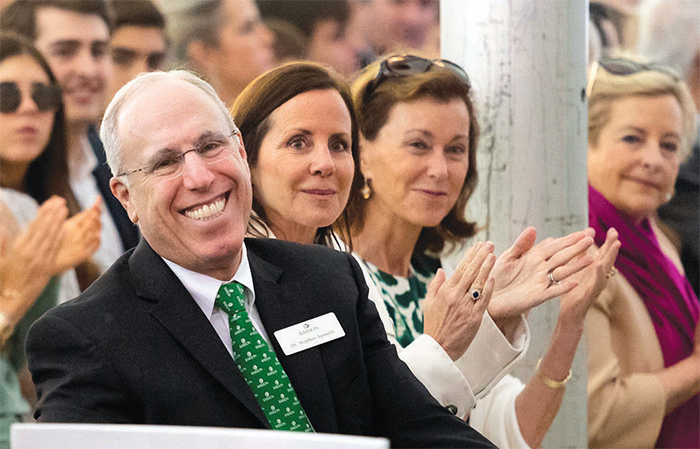
President Stephen Spinelli Jr. MBA’92, PhD at Babson’s Centennial Commencement ceremony.
Photo: Justin Knight
When he was a professor, Spinelli’s colleagues were pioneers of entrepreneurship at the College, professors William Bygrave and Jeffry Timmons. Spinelli and Timmons co-authored several editions of a book, New Venture Creation: Entrepreneurship for the 21st Century, that lays some of the groundwork for what would become Entrepreneurial Thought & Action®, the College’s key methodology for developing an entrepreneurial mindset.
When he returned to campus earlier this year, Spinelli saw how the seeds of entrepreneurship had continued to grow and flourish in his absence. “I saw how that lineage had grown, and that was motivating, exciting, and energizing,” he says. “Seeing that growth, you say, ‘Is there anything left to do?’ To be honest, there’s plenty.”
The Need for Knowledge
Spinelli takes over at Babson in a time of tumult in higher education. Dwindling enrollments and changing demographics are among the challenges many institutions are facing. Since 2016, more than 100 colleges and universities in the U.S. have closed. “Everybody is scared to death about what is going to happen in the future of higher education,” he says.
To counter that fear, Spinelli poses a question: Will the need for learning and knowledge be greater today or tomorrow? Or how about this year versus next? Spinelli believes that as the world continues to change so briskly, the need for education and continual learning will only increase.
That’s good news for colleges. If they’re open to collaboration and willing to adapt, Spinelli believes that they can prosper and meet that never-ending demand for knowledge. “Opportunity starts with demand,” he says. “If there is demand and we put together a business model that can fulfill that demand, we’re going to win.”
Spinelli warns that Babson is not immune to the market forces affecting higher ed, and the College is now embarking on a strategic planning effort for the future (see “Share Your Thoughts on the Strategic Plan”). The world is full of change, and Spinelli vows that the College will be ready. “Change is fertile ground for Entrepreneurial Thought & Action,” he says.
To be sure, the need for entrepreneurship education is not going away. In fact, Spinelli feels that the ability to think like an entrepreneur could become a required competency for the workplace. Who is better at navigating uncertainty and creating value than an entrepreneur?
“You should be thinking that way as an administrative assistant or a founder of a company or a general manager or an accountant. I do believe that,” says Spinelli. “The impact of Babson could be even greater over the next 20 years or 100 years than it is today.”
]]>“When I asked my dad about his prospects for the company—selling the business, joining with other businesses, selling shares, or becoming public—the first thing he asked me was if I really wanted to be part of the business,” Isidoro says.
His dad, Leo Katz, wasn’t expecting so many questions. “But,” says Isidoro, “it was also reassuring to see how much he wants us to continue with the business and work alongside him.”
Conversations like these, in which family members tackle challenging questions about the family business, underline the goal of Babson’s new Family Amplifier course, part of the College’s Institute for Family Entrepreneurship (IFE).
Started in 2018, almost 100 years after Babson opened with a founding mission to educate the next generation of family business leaders, the IFE launched to better serve the numerous students with family business backgrounds. Among Babson’s undergraduates, approximately one-half hail from families with businesses.
The institute’s latest offering is its Amplifier course, a unique program designed to prepare students for a future role in their family enterprise. Students engage with their families, asking thoughtful, investigative, and sometimes tough questions. The course offers an immersive experience to create a shared business vision that includes the next generation.
Lauri Union, executive director of the IFE, says the Amplifier embodies Babson’s philosophy of creating economic, social, and family value across generations and time. With 70 percent of the global GDP stemming from family businesses, Union believes facilitating conversations about the entrepreneurial legacy of the family is key.
“The homework involves students interviewing their parents, so it is a family experience happening while the students are in school,” she says. “While it is unique, we think it’s essential in terms of families being able to explore their values together and foster their capacity to act entrepreneurially.”
The first student cohort went through a competitive application process. Originally, organizers planned to accept 10 students for the launch, but with 50 compelling submissions from students all around the world, they expanded to 20. Families had to be engaged in an entrepreneurial venture such as a business, a family office, or an investment platform.
The initial group included many international students with family businesses ranging in size from two to 60,000 employees. Some students have worked with their family business in the past, and some haven’t been as directly involved, but all are eager to explore the dynamics of family entrepreneurship with each other and their relatives.
The program includes twice-monthly classes where students discuss family business concepts, engage with guest speakers, and learn about each other’s operations. The homework—exploring the business’s history and potential and talking to involved family members—is what sets the class apart. The process has been eye opening for students.
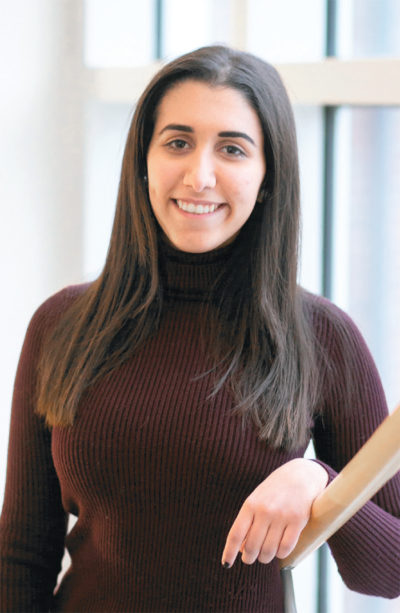
Through the Amplifier program course, Nicole Atala Asfura ’19 connected with her family in a new way.
Fostering Family Dialogue
Nicole Atala Asfura ’19 entered new territory by having these kinds of conversations with her family, which owns a third-generation, Honduras-based financial business, one of the biggest enterprises in the nation and Central America. Helmed by Atala’s father and his four brothers, Grupo Financiero Ficohsa operates in four countries and has several U.S. branches.
Atala, who will graduate in May with a double concentration in strategic management and entrepreneurship, says she was drawn to the Amplifier course. She knew family members’ roles in the business needed further discussion.
“I saw the Amplifier program as an opportunity to provide support on what our goals should be,” she says of the fast-growing company, “and an opportunity to experience this with the insights of other families, alumni, and resources connected to the program.”
Atala admits she found the required discussions with her father and uncle challenging at first, as the men offered only one-word answers without much elaboration. But once she pressed for specifics, she connected with them about the business in a different way. She’s excited to gain knowledge on operations, future projects, and their five-year plan.
Her father, Luis Alberto Atala Faraj, also knew it was important for the family to be in sync on issues of entrepreneurship. He says he benefited by connecting more with his daughter and hearing her point of view. “It makes us reflect on aspects of the family business we need to think more about.”
Strengthening Bonds
Elizabeth Reed ’19 grew up working as part of the third generation of her family business, Storee Construction, an industrial construction company that her mother and two uncles own in Missouri. Under the guidance of her mother, Reed worked in almost every department of the business, including accounting, purchasing, human resources, and project and safety management.
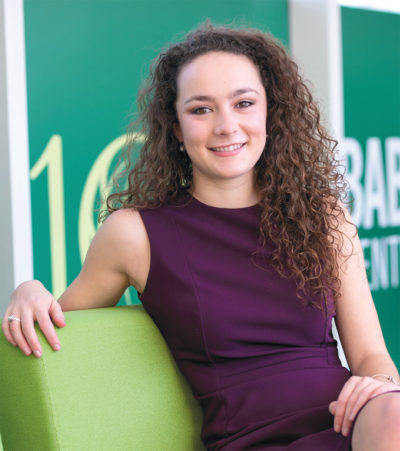
Through conversations with her mother, Elizabeth Reed ’19 knows she’ll be able to shape her role in the future of the family business.
Reed came to Babson to pursue her interest in business as a Center for Women’s Entrepreneurial Leadership Scholar and member of the women’s varsity soccer team. As a senior, Reed was thrilled to be one of the 20 students in the pilot Amplifier course, and she appreciated the chance to have her mother, Amanda Reed, directly involved in her schoolwork and education.
One of the first class projects focused on goals and leadership, and Reed asked several members of her family to create and prioritize a list of life and business goals.
The conversation with her mother included guided questions around her mother’s vision for the company, “her vision of me as her daughter, and the opportunities to be involved in the continued growth of the company as a part of the family business’s third generation,” Reed says.
“Together, we explored the goals my mother had as a business owner and the value she saw in utilizing the capabilities and interests I’ve developed both inside the company and outside, while pursing my management consulting career.”
These conversations also gave Reed the confidence that her family will give her an opportunity to help shape how she is involved in the future of the business.
“Through the Amplifier course, Elizabeth also gained insight into navigating the power dynamics that are inherent to all family businesses,” Amanda Reed says.
Elizabeth Reed always intended to stay involved with the family business, but says the Amplifier course helped her build a more concrete plan for the future. Throughout her four years at Babson that involvement has ramped up; she’s focused on systems integration to help create a new competitive edge for Storee’s project management.
Focusing on Family Interaction
Matt Allen, faculty advisor to the IFE and academic director of the global Successful Transgenerational Entrepreneurship Practices Project at Babson, says he created the Amplifier course based on his experience teaching other family entrepreneurship classes, and worked with other Babson faculty to develop the class. The program will launch in the graduate school this fall.
“According to family theory, relationships and interaction between family members play a key role in how families understand themselves and each other,” Allen says. “More importantly, the quality of interactions can define the ability of families to work together. In typical business education, the family is ignored. Instead, emphasis is placed on content such as operations, finance and marketing—but this content does not prepare students to actually function effectively within the family.”
Students, he adds, are often transitioning from a traditional parent-child relationship into one that will eventually become more professional. “As students study away from home and the family, the relationship does not mature as quickly as the students themselves. The family is learning to readjust and come to a new balance of understanding based on new roles in the family and the business. Thus, the name of the course; we are amplifying the family’s ability to build and grow entrepreneurially.”
The class will eventually cover three years of the undergraduate experience, with the current course, focused on enhancing family relationships, offered to sophomores. As juniors, students will concentrate on improving their understanding of the business and work with their family to discover entrepreneurial opportunities. As seniors, students will work directly with their families to fulfill one of the opportunities defined during their junior year.
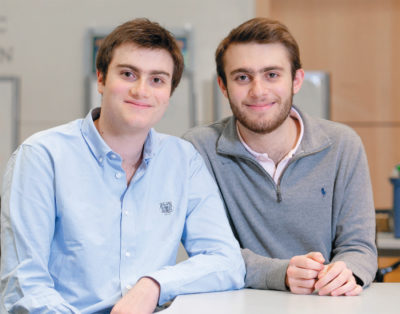
Twins Isidoro (left) and Jonathan Katz ’21 discovered how much their father wanted them to work in the family’s business in Bogota.
Continuing on the Amplifier Journey
Isidoro Katz will continue on the Amplifier path as it evolves. He was born into his Bogota, Colombia, family business, comprised of more than 20 restaurants and food purveyors, mostly under the Zona K brand. Katz’s sister, Michelle, graduated from Babson in 2017, and twin brother Jonathan is currently in the Amplifier program with him.
He appreciates connections he made in the classroom: “I really liked how we could connect with other students and learn what they are doing, how they are similar or different, and what they value the most.”
Before he started the Amplifier course, Katz didn’t know if he wanted to return to Bogota and join the family business immediately after graduation, or follow in his older sister’s footsteps and take some time to work in the U.S. He’s still unsure of his path, but knows he will ultimately work in his family business.
Whatever Katz decides, this course will help him reach his goals by amplifying conversations for the next generation of family entrepreneurs.
Paige Wolf is a freelance writer in Philadelphia.
]]>Specifically, they are Roger Babson’s boulders. Babson was a man brimming with notions and ideas, and the boulders were something he dreamed up during the Great Depression. Wanting to offer the dignity of work to unemployed stonemasons in his hometown of Gloucester, Massachusetts, Babson instructed them to carve inspirational sayings into boulders that dotted the abandoned colonial settlement of Dogtown Common.
Photographs of those boulders, along with their accompanying mottos for living, hang on the walls of Healey’s office. The words on the boulders seem to call out to visitors: Courage. Kindness. Study. Truth. Integrity.
When asked what words she would carve into rock like Roger Babson, Healey doesn’t hesitate giving an answer. “Lead with humility,” she says. Since the summer of 2013, Healey has served as Babson’s president, and that message of humility is something she takes to heart. “I think that much wisdom comes from disappointments and failures,” she says. “In each challenge, one can find insights, inspirations, and new opportunity.”
As Babson’s 13th president and the first woman to hold the position, Healey has overseen many successes during her tenure, including new programs, new campus construction, and a new energy and enthusiasm for giving in the alumni community. But, as she prepares to step down in just a few months, Healey always carries that humility with her. “Leading a college is a collaborative activity,” she says. “You can’t approach it with enough humility and openness to other perspectives. That allows you to serve others more ably and to amplify the diverse talents around you.”
Links in a Chain
The end of a presidency is a natural time to take stock, to look back. That’s especially so in 2019, as the College celebrates its Centennial.
Such a moment of reflection happened on a Friday night in February. Healey found herself surrounded by history as Babson welcomed back all its living presidents for an event billed as a fireside chat. They gathered on stage in the Sorenson Center for the Arts: Ralph Sorenson, H’85, William Dill, H’91, Leo Higdon Jr., H’07, Brian Barefoot, ’66, H’09, P’01, and Leonard Schlesinger, H’14. (William Glavin, H’99, was unable to attend due to the recent death of his wife, Cecily, H’97.)
Babson College’s Past Presidents »
With Healey serving as moderator, her predecessors reflected on the challenges they faced, the triumphs they saw, and the times that shaped the institution they led. Each president’s answers led to the next president’s, one link in a chain to another, the entire stage taking in the sweep of decades. “It was wonderful to see how the presidents fed into each other’s narratives,” Healey says. “The themes and passions of each president were built upon by the next president.”
That was particularly true when discussing entrepreneurship. On the far side of the stage sat Sorenson, who first focused Babson on entrepreneurship in the late 1970s. Each president, in turn, added to the framework he laid out. “I now have the great honor to be the person who takes that expertise into Babson’s next century,” says Healey.
When Healey first stepped on Babson’s campus, the former lieutenant governor of Massachusetts admits, “I had a great deal to learn about what it means to be part of a college community.” She also had a lot to learn about Babson. “I never could have imagined when I saw this small college in Wellesley that it has an alumni footprint in 119 countries around the world,” she says.
But, now, nearly six years into her term as president, she is like the others on the stage, one more leader building onto a strong foundation. When she thinks about how she added to Babson’s history of entrepreneurial education, Healey points to the Institute for Family Entrepreneurship. Launched in 2018, the institute is a hub dedicated to education, research, and programming for students and families looking to carry on a legacy of entrepreneurship.
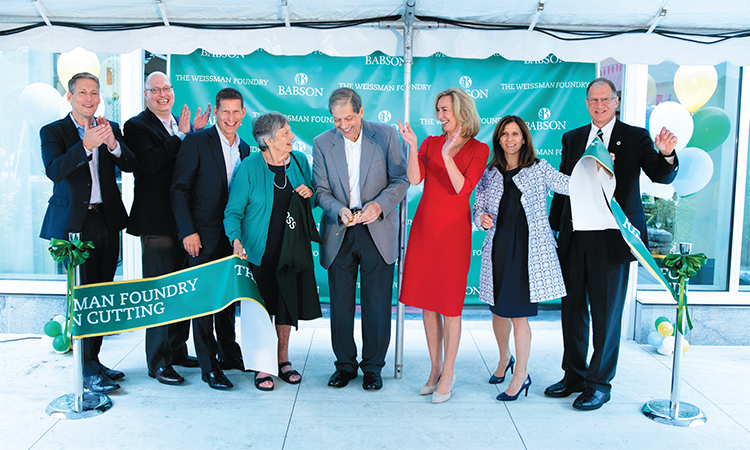
On September 21, 2018, Babson College celebrated the official opening of the Weissman Foundry with a ribbon-cutting ceremony. From left to right: Christopher Weissman MBA’90; Michael Weissman ’87, P19; Greg Weissman; Jan Weissman P’87, ’90; Robert Weissman ’64, H’94, P’87, ’90; President Kerry Healey; Board of Trustees chair Marla Capozzi; provost Mark Rice.
Considering that family businesses create more than 70 percent of the world’s GDP, Healey sees the institute as an opportunity for the College to expand its reach and impact. “I can see the College becoming the global leader for family business in its second century,” she says. “There is no other business school as uniquely focused on making sure there is an entrepreneur in every generation of a family business.”
Achievements on Campus and Beyond
Launching the institute, however, is just one of Healey’s accomplishments. Her presidency has helped shape many aspects of the Babson community, both in Wellesley and beyond.
There’s diversity, for instance. Healey’s tenure has seen increased racial, ethnic, and socio-economic diversity on campus among students, as well as the first majority female undergraduate class in Babson’s history. Early in her presidency, she established the Global Scholars Program, the first full-tuition scholarships at the College for international students.
“I am probably the most proud of the Global Scholars Program,” she says. “Their contribution on campus has been profound. They have participated in so many activities. They have started so many programs. They have enriched discussions in the classrooms. And, they will go back to their home countries and have significant positive impact.”
Increasing alumni involvement is another hallmark of the Healey years. When she began at Babson, the alumni giving participation rate was just 13 percent. The rate is now more than 30 percent, and donations from international alumni have increased 500 percent during that time. In 2018, the College had its best fundraising year ever, pulling in $67 million. “That was a wonderful milestone to reach,” Healey says.
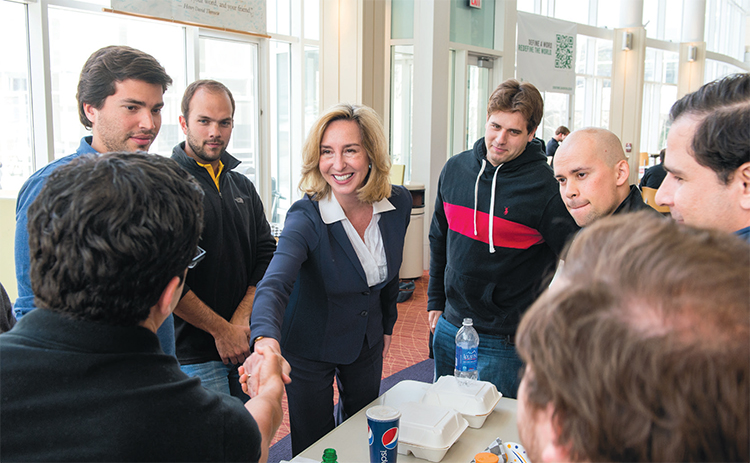
President-elect Kerry Healey greets students and faculty after the press conference announcing her selection as Babson’s next president.
Healey gives a lot of praise to the development, events management, and Alumni and Friends Network staffs for this increased participation. She also gives credit to Babson Connect: Worldwide, a global entrepreneurship summit that she founded to engage with the Babson community around the world. First held in Cartagena, Colombia, in 2015, the annual event has taken place in Dubai, Bangkok, and Madrid. In honor of Babson’s Centennial, this year’s event will occur in Wellesley and Boston in September.
Another Healey accomplishment can be viewed by taking a walk around Babson’s campus. In recent years, she has overseen a number of construction projects that have transformed the look of campus: Park Manor West, the new Roger’s Pub & Grille, the Weissman Foundry, and the soon-to-be-completed Babson Recreation and Athletics Complex and the Babson Commons at Horn Library. “I am very excited to see College Drive coming to life in the way it is,” says Healey, who applauds Babson’s facilities department. “I am in awe that they are able to carry all this off on budget and on time. It takes a lot of effort and determination to make that happen.”
Part of the campus transformation has been the moving of the Babson Globe to a place of prominence. Instead of being tucked away behind Coleman Hall, it’s now in a new park on College Drive that also will include flags from the home countries of all current Babson students, a statue of Roger Babson, and markers telling the College’s history. Healey sees the recently repainted globe and the display of flags as a symbol of what the College stands for. “It tells people that we are a global campus,” she says. “We think business happens everywhere, that entrepreneurs are found everywhere.”
Thanks to the contributions of more than 100 donors, the new park will be named Kerry Murphy Healey Park. “I was deeply touched,” Healey says.
Looking to the Future
Other accomplishments include the expanding of the College’s presence in Boston, Miami, and Dubai, and the providing of free, online entrepreneurship courses to more than 200,000 students hailing from nearly every country. But, sitting in her office, surrounded by Roger Babson’s boulders and a view of the Babson Commons construction out her window, Healey would rather talk about the College’s future.
She’s excited by the choice of Stephen Spinelli Jr. MBA’92, PhD, to be the College’s next president. “He has a great love of Babson and a knowledge of the community that spans decades,” she says. She’s curious how he will build on the College’s mission, just as she and all the ex-presidents did before him. “I’m sure President Spinelli will have a great degree to offer in that regard,” she says.
Healey believes the future looks vibrant for Babson. “I’m excited to see where Babson goes now, over the next 10 or 20 years,” she says. “I strongly believe the College is positioned for success. The world needs what Babson is offering. The students that are drawn here are among the most talented in the world.”
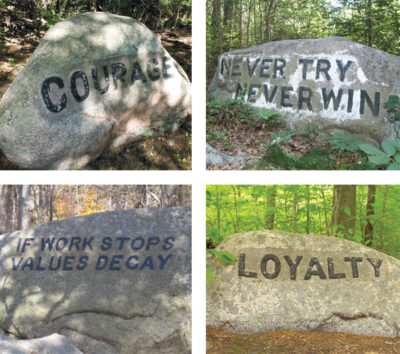
As she prepares to join the ranks of former presidents, Healey says those students will be what she misses most about her time at Babson. “They have so much hope for the future,” she says. “They are so self-motivated and optimistic. It is wonderful to be around young people who have so much confidence and self-reliance.”
Looking ahead to her own future plans, Healey says she is keeping her options open but is looking forward to the publication of her forthcoming book, The Politics of Dignity: An Agenda to Unite America’s Moderate Majority. It focuses on how human dignity can guide public policy, a timely topic for these divisive times. “I believe that our failure to honor each other’s dignity in our policies and rhetoric has driven our country apart,” she says. “I believe the path toward national renewal lies in embracing policies that advance our human dignity.”
Before Healey steps down, however, she has one last special trip to make, one that could involve Spinelli as well. While she is obviously a big fan of Roger Babson’s boulders, Healey admits she has never seen them in person. “I will plan a trip before I depart Babson,” she says. “Maybe, I’ll take Steve with me.”
]]>Today, students arrive at Babson from more than 80 countries and work diligently, no punching out required, to learn entrepreneurship and other business essentials, such as finance, accounting, marketing, and operations management. Foundations of Management and Entrepreneurship is a first-year undergraduate course in which students create, build, and start a business. Some 127 entrepreneurship courses are offered, taught by 53 faculty members, most of whom have considerable entrepreneurial experience. U.S. News & World Report has ranked the F.W. Olin Graduate School of Business at Babson College the No. 1 program for entrepreneurship for the past 26 years.
“We have the largest separate department of entrepreneurship in the world, and yet we’re a small school,” says Candida Brush, The Franklin W. Olin Distinguished Chair of Entrepreneurship and Vice Provost of Global Entrepreneurial Leadership.
This evolution, which has progressed from the college’s buttoned-up beginnings to its modern-day role as an entrepreneurship powerhouse, has been years in the making, with enlightened Babson leaders seizing opportunities to push beyond boundaries at key moments. Over the years, these trailblazers have backed up big-picture thinking with programs and classes emphasizing experiential learning designed to give students a decided advantage in their career path, building on and modernizing Roger Babson’s original vision.
This vision didn’t always take precedence. In the years following the Great Depression and World War II, company loyalty was in; an entrepreneurial mindset was out.
“The 1940s, 1950s, 1960s, and 1970s were the eras of big business. The attitude of the time was, do good for your company, and the company will do good for you,” says William Bygrave, entrepreneurship professor emeritus at Babson College.
Bygrave credits two former Babson professors for boosting the College’s reputation in entrepreneurial education: Karl Vesper, who started the Babson College Entrepreneurship Research Conference (BCERC), and the late Jeffry Timmons, who created the Price-Babson Symposium for Entrepreneurship Educators (SEE).
President Ralph “Bud” Sorenson arrived in 1974. He took control—wooed from Harvard Business School by the spirit and air of friendliness at Babson, he says—in a difficult era for entrepreneurship, but one rife with opportunity.
During his tenure, he pushed the school to define itself as a leader in entrepreneurship. Under Sorenson, Babson became a pioneer in the field of entrepreneurship, making the school the first to establish entrepreneurship as a discrete academic discipline.
Carving a Niche
Sorenson reflects on his time at Babson from his airy carriage house off of Brattle Street in Cambridge, Massachusetts. He recalls his seven-year presidency with a twinkle in his eye and a modest grin.
“My thought was to identify an underserved niche that had potential and would give Babson a distinctive competitive advantage,” he says. “A lot of people thought, ‘You cannot teach entrepreneurship. You’re either born with the entrepreneurial gene, or you’re not.’”
Sorenson didn’t buy the idea of entrepreneurship as the birthright of those coming from a family business. He analyzed what graduates had done after Babson and noticed that a significant number had become presidents and CEOs of companies; many were self-employed. With the encouragement of late professor Jack Hornaday P’76, H’99 who already was teaching entrepreneurship, he knew he’d found Babson’s niche.
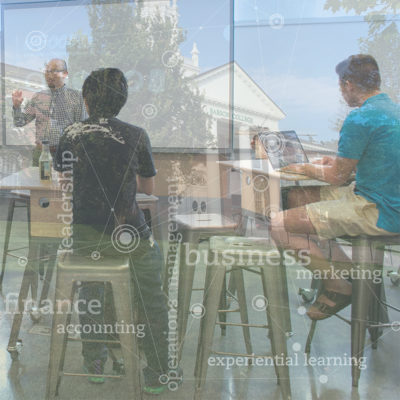
Art: Cathy Cahill
“It built on a historical tradition already in place at Babson, there were no other business schools with such a specialty, and such a focus had a good chance of winning the support of most of the management faculty, regardless of their functional area,” he says.
He set in place several seismic shifts. More courses and outlets for entrepreneurship were added at the undergraduate and graduate levels, including the Center for Entrepreneurship Studies in 1978 and a newly established undergraduate entrepreneurship major in 1979. The Center for Entrepreneurship created BCERC in 1981, one of the first of its kind. SEE began a degree outreach program to help faculty at other business schools teach entrepreneurship, establishing Babson as a leader in the field.
“There are now 8,000 graduates of that program and people who are teaching entrepreneurship education around the world. That’s a large reason why we’re still ranked No. 1,” Sorenson says.
He also was shrewd enough to capitalize upon the power of celebrity.
In 1977, Sorenson devised a way to draw attention to the school’s new mission: The Academy of Distinguished Entrepreneurs, an annual induction ceremony drawing the biggest names in business. While many business schools maintained hall of fame programs, this was the first to pay homage to outstanding innovative entrepreneurs who created wealth and jobs.
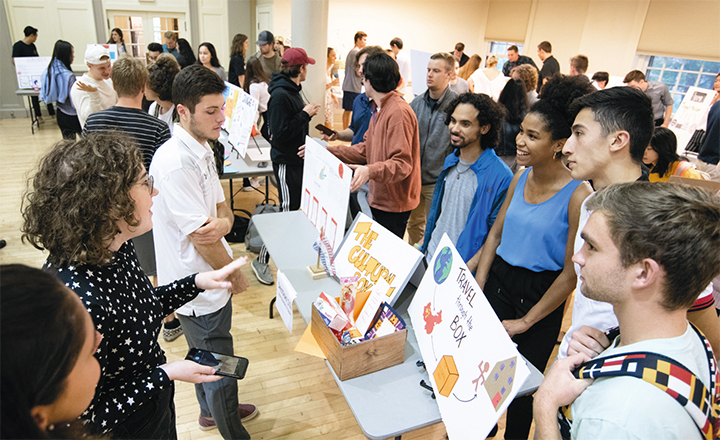
In Foundations of Management and Entrepreneurship, students develop and launch a real business.
Photo: Tony Rinaldo
The first ceremony honored Motown’s Berry Gordy Jr.; McDonald’s founder Ray Kroc; Soichiro Honda, founder of Honda Motor Co.; Ken Olsen, co-founder of Digital Equipment Corp.; and Royal Little, founder of Textron. Since then, the academy has honored more than 100 people.
An Entrepreneurial Mindset
Entrepreneurial thinking—not merely entrepreneurship as a discipline—is the fundamental part of Babson’s campus culture.
This is largely due to President Len Schlesinger, who arrived on campus in 2008 eager to further differentiate the College and redefine entrepreneurship for a new era. At Babson, entrepreneurship had become a way of thinking adaptively and creatively, for economic and social good.
Babson harbored the philosophy but lacked the language to communicate it concisely. Schlesinger was three months into his tenure when Danna Greenberg, the Walter H. Carpenter Professor of Organizational Behavior, uttered a captivating phrase during a faculty listening session: “entrepreneurial thought and action.”
Schlesinger seized upon it, and Entrepreneurial Thought & Action became Babson’s trademark calling card.
The seven directives of ET&A are: the strong desire to create; beginning with what you have, rather than what you think you need; paying only what you can afford to lose; enrolling others in your journey, as ET&A is about collaboration rather than competition; taking small action—with no excuses; building on what you learn; and reflecting and being honest with oneself.
The methodology can be used anywhere, from a big corporation, to a nonprofit, to a family business. It urges entrepreneurs to pivot between traditional prediction logic, relying on analysis, to creation logic, or feeling emboldened to take action despite unknowns.
Naming this methodology solidified Babson’s mission, further distinguishing it in a crowded market as more schools began to teach entrepreneurship.
Schlesinger vowed to make Babson the only school that applied that entrepreneurial mindset to five key areas: large organizations, social innovation, family businesses, scale-ups, and startups. Trademarking the phrase Entrepreneurship of All Kinds, he emphasized that anyone can become an entrepreneur, and that entrepreneurial thinking could be taught.
“The notion that, given uncertainty in the world, entrepreneurship is the framework for new leaders was a way to essentially argue that what we do in entrepreneurship applies everywhere as it evolves,” Schlesinger says.
The directive is baked into Babson’s vision statement: to expand the notion of entrepreneurship to embrace and celebrate entrepreneurs of all kinds.
Taking the Initiative
Today, ET&A is the underpinning of every Babson initiative. The Babson Academy for the Advancement of Global Entrepreneurial Learning offers programs that develop faculty to teach entrepreneurially, as well as entrepreneurship boot camps for undergraduate and graduate students at 37 other institutions. Both are instrumental in growing the Babson method exponentially. The Global Entrepreneurship Monitor research consortium, part of The Arthur M. Blank Center for Entrepreneurship, involves more than 500 researchers worldwide and is the most developed research program on entrepreneurship in the world. The Center for Women’s Entrepreneurial Leadership is host to the Diana Project, an annual conference providing more than 100 scholars with a platform to share global research dedicated to women entrepreneurs and their ventures.
At the Blank Center, hundreds of entrepreneurs and businesses use the John E. and Alice L. Butler Launch Pad as an incubator to jump-start their businesses, with advisory support from Babson faculty. Other students test their ideas at the annual Rocket Pitch, a fast-paced showcase that also draws students from neighboring Olin and Wellesley colleges, where students pitch business ideas to potential investors. The B.E.T.A. (Babson Entrepreneurial Thought & Action) Challenge is a competition that rewards the top undergraduate, graduate, and alumni who put Babson’s ET&A methodology into action with a $20,000 grand prize.
“Today, entrepreneurship classes are everywhere,” says Brush. “Entrepreneurship books? There are thousands of them. Here at Babson, we knit together what goes on in and out of the classroom to create a culture that’s hard to replicate, where we connect student experiences through immersive lab experiences to the learning inside the classroom.”
This tradition of applied learning will prove critical in the years ahead, says Sorenson.
“There is a famous saying: ‘One thorn of experience is worth a whole thicket of advice.’ And that goes back to where I think Babson has a bit of a head start,” Sorenson says. “The whole idea of formal education beginning in kindergarten, ending with a degree, either high school or college, and that’s the end of the approach? That’s so yesteryear. We have to become lifelong learners, given how fast the world is changing.”
Kara Baskin is a freelance writer in Arlington, Massachusetts.
]]>